Water
Beagle Water Requirements
No doubt you've put a lot of thought into what you feed your Beagle puppy or dog for both hearty meals and healthy snacks, however just as much thought needs to be put into the water that your Beagle ingests. You might assume that your Beagle will drink what he needs, since he has access to water at all times, however this is not the case for many dogs.
Due to several factors, a Beagle of any age can have a slight dehydration issue that results in surprising consequences to the mind and body.
In addition, the quality of the water that your Beagle drinks will have long term effects to his health and even possibly his life span.
Since this is such an important topic, this section will cover everything you need to know including:
- How much water a Beagle needs to drink each day
- Reasons a Beagle may not drink a lot
- The effects of low and moderate dehydration
- Drinking too much or too fast
- Why you may want to rethink the choice to give your Beagle tap water
- Helpful tips to help a Beagle well hydrated
- Getting a Beagle to drink when he/she is ill

Maxine, 7 months old
Photo courtesy of Gladys Luria
How Much Water Beagles Need
The amount of H2O that a Beagle needs is dependent on 4 factors:
1. The dog's size
2. The dog's activity level
3. The temperature that the dog is exposed to
4. Health status
Let's take a look at this in more detail:
1. Size-
When figuring out if your Beagle is drinking enough, you'll want to start with an easy formula based on his or her weight; the other factors will come into play after we have this base volume.
A typical dog of any age 5 months and up, requires 1 ounce of water for each 1 pound of body weight. And young puppies (2 to 4 months) generally require a bit more, up to 1.5 ounces.
How much exercise a Beagle receives, the temperature both outdoors and inside and health status (including pregnancy) may cause this number to increase to as much as double (more ahead); however to begin with, your Beagle will need this following amount as the bare minimum:
Weight = Water per Day Oz. /Cups
5 lb. puppy = 7.5 ounces or .93 cups
10 lb. puppy = 15 ounces or 1.88 cups
15 lbs. = 15 ounces or 1.88 cups
20 lbs. = 20 ounces or 2.5 cups
25 lbs. = 25 ounces or 3.13 cups
30 lbs. = 30 ounces or 3.75 cups
35 lbs. = 35 ounces or 4.38 cups
40 lbs. = 40 ounces or 5 cups
So as you can see, Beagle puppies should be drinking at least a cup of water each day, growing adolescents need increasing amounts of H20 as they mature and most adult and senior Beagles should be drinking 3 to almost 5 cups per day.
2. Activity Level-
The guidelines for water requirements takes into account the normal activities of a typical dog. If he has more activity than his normal twice per day moderate walks, such as a trip to the dog park, an extra walk, a game of fetch in the yard, etc. this will equal a greater need to rehydrate. Many owners assume that a Beagle will drink as needed, however this is not always the case (more ahead).
3. Temperature-
Beagle owners should take into account not just the outdoor temperature, but also indoor as well. For example, if it's the middle of winter
and chilly you may assume that there is no reason to encourage increased water consumption, however if the house is kept very warm with dry heat, there may be a need to boost water intake a bit which will help combat dry skin and other such issues.
Alternatively, if you're in the middle of the summer season, your Beagle's needs may or may not change. If he is only taken out for walks in the early morning and late evening, spending most of his time in an air conditioned house, he needs should stay about the same. If he's rather active outdoors, his needs may double.
As a side note, if a Beagle is indoors during the summer without a cooling system (i.e. the AC breaks, etc.) not only will he require more water, other cooling methods such as a cooling mat and/or bandana should be implemented as well.
4. Health Status
- With pregnant dogs there will be increased thirst and hunger generally beginning by day 35. If a Beagle is recovering from any sort of stomach distress, vomiting
episode, a bout of diarrhea or other health issue that causes a loss of body fluids, the dog will need to drink more to replace those fluids.
In cases of moderate to severe vomiting and/or diarrhea, there will typically be an electrolyte imbalance (most notably trace minerals and sodium)and lowered blood sugar levels that may need to be treated with an oral rehydration solution such as Pedialyte.
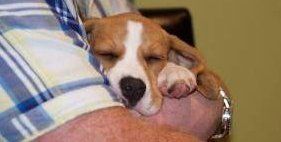
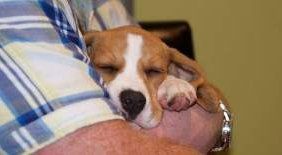
Bentley, Photo courtesy of C. Windust
Reasons a Beagle May Not Drink Enough Water
There are several reasons why a dog will not meet his H20 requirements:
1) Water condition-
There are 2 main elements involved:
Purity -
With the busy lifestyles that most owners have, it's easy to overlook the need for fresh water. If you see that the bowl is at least half full, you may simply top it off. It may not occur to you that your Beagle may be drinking less due to biofilm that has accumulated. Have you ever noticed a thin, slimy film either floating on top of your Beagle's bowl or clung to the bottom of it?
That's biofilm… a collection of the dog's saliva and bacteria that feeds off of food remnants that are deposited into the dish.
If you notice a pink colored film, this is often due to a bacterium known as Serratia marcescens. A green film often points to algae. Ahead, we will dive into some great ways to keep the water fresh & clean.
Temperature -
Dogs, in general, will drink more water when it is chilled, especially on warm to hot days. Tepid H2O is not that appealing and while a dog will drink some when he is thirsty, he'll most often drink more if it is cool.
2) Limited access -
If your Beagle drinks up before you take him out and then again when he gets back into the kitchen and you assume this is just fine, you're not alone. However, what a dog drinks when he returns home after moderate exercise
is not always going to replace what he lost. If you take your dog out for any amount of time over 20 minutes or on hot days, be sure to bring along liquid refreshment.
Canine travel containers are often a good choice, since the lid serves as a bowl (making it compact and easy to bring along) and the opening is large enough for you to slip in a few ice cubes to keep the water cold. Whether you're out exploring or letting your Beagle enjoy romping around at the dog park, take a break every 20 to 30 minutes to offer a rest in the shade and some chilled water.
3) Playing catch-up -
Us humans often struggle to drink enough fluids simply due to the fact that we may not drink until we actually feel thirsty… and this is no different for our dogs. A Beagle, unless encouraged (more ahead), may not drink his water until he is really feeling thirsty…
Particularly if there are distractions such as visitors to the home, he's playing a game with someone, etc. It's easy for this to happen and even though the puppy or dog will lap at his water throughout the day once he's no longer distracted, he'll be lagging behind.
4) Health issues -
There are a few health conditions
that may cause decreased thirst in canines. This includes diabetes (often causes increased thirst however in some cases, the opposite may be true), kidney disease, bladder infection or UTI (urinary tract infection). Any sort of intestinal or stomach distress may cause a Beagle to resist eating or drinking.
Older, senior dogs that are suffering from arthritis, joint pain or other conditions that cause discomfort or pain may not drink as much water due to not wanting to rise and walk over to the bowl as often as they otherwise would.
Beagles with Mild Dehydration
Many dogs suffer from mild dehydration simply because owners understandably assume that their Beagle will drink the exact amount of water that his body needs. After all, you leave the bowl out at all times and your dog has access to it 24/7.
Yet, as we discussed above, there are many reasons why a Beagle may not drink enough.
This is categorized by a 1.5 to 5% loss of normal body fluid. Just a 1.5% loss is often not enough for owners to really notice, but it is enough that it can affect your Beagle.
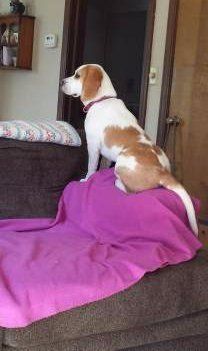
Miss Bella, 6 months old
Photo courtesy of Joanne McClue
The 4 top signs of this are:
1. Loss of focus -
The Beagle may not be able to concentrate as usual. This may be noticed when giving commands or when you are engaged in training.
2. Mood changes -
There may be slight agitation or irritability.
3. Headache -
While many of us may think of this as just a human ailment, canines can and do suffer from headaches. With even mild dehydration, the fluid that surrounds the brain will actually decrease in volume and this can cause pain to radiate around the skull. Signs include aversion to light, noise and/or rubbing the head against surfaces.
4. Dry skin -
While allergies
are the most common cause of skin issues and the grooming products that you use to bathe and care for your Beagle's coat play a role in skin and coat health, dry skin can also be the result of a chronic lack of adequate water intake.
Signs of Moderate to Severe Dehydration
Loss of elasticity of the skin -
This can be tested by noting the reaction time after pulling on the Beagle's scruff. Gently pull the skin on the top of the shoulder blades/back of the neck out 2 inches from the body. With dogs that are well hydrated, the skin will retract back to normal in less than 2 seconds.
Dry gums -
The gums should be pink, bright and moist. If they are tacky or sticky and/or show gobs of thick drool
on them, this is a warning sign.
Sunken in eyes -
The eyes will appear hollowed and gaunt.
Weakness -
The dog will be clearly struggling, unable to move as normal and very listless.
Change in heart rate -
The will be increased heart rate (tachycardia) or a weak pulse, depending on the stage of distress. A dog's normal heartbeat will be between 60 and 140 beats per minute. We do encourage owners to know what their Beagle's normal heart rate is, when the dog is at rest and in good health. To check your Beagle's heart rate, firmly place your hand on the left side of his/her chest. You will feel the beats with the palm of your hand. Count the beats for 15 seconds and then multiply that number by 4.
Eventual collapse -Without intervention, the dog may faint or go into shock due to organ failure. At this point, it can be fatal even with treatment.
When a Beagle Drinks Too Much or Too Fast
Increased thirst - Random incidences of drinking a lot of water is most often connected to exercising more than normal or in hot conditions. In some cases of a
food change (wet to dry), if a dog receives less water via his meals, he may up his water intake.
There are, however, some health conditions that do have increased thirst as a main symptom. Most notably, this includes: diabetes, kidney disease, thyroid disease and Cushing's disease.
Drinking too fast -
Does your Beagle dive his nose into his water and gulp the whole bowl down before you can blink your eyes? You may have reason to be concerned.
While many owners equate a dog eating too fast with bloat, drinking too quickly can also trigger this sometimes fatal and always serious emergency condition. You'll definitely want to take steps so that your Beagle drinks his water at a reasonable pace and you can help by either pouring it into a slow-feeder bowl or by placing a portion pacer in the bowl.
Additionally, by encouraging water intake all throughout the day and by bringing water with you when you take your Beagle out for a walk, a run or a game of fetch (anything that gets his heartbeat up and makes him thirsty), this can keep him from getting so parched that he guzzles his H2O too quickly when he gets back inside.
What You Need to Know About Tap Water and Your Beagle
Many dog owners don't give this a second thought… after all, if you rent, it's free…and even if you own and have a water bill, what could be more convenient than to simply turn on the tap and fill your Beagle's bowl?
However, there are some valid reasons why this can adversely affect your Beagle's health. When ingested day after day, for months, for years, the elements commonly found in tap water around the US and Canada - and how these can affect a dog's health- is quite startling:
1) Fluoride-
According to the CDC (Centers for Disease Control), 2/3 of cities in the United States have fluoridated water
and in Canada, a little over 45% of Provinces and territories have fluoridated water. If you live in Europe, you're lucky; 98% of Europe's public water is fluoride free.
While the debate is ongoing in regard to whether or not this prevents tooth decay in humans, it is clear that it is toxic to canines.


Dorie Bailey, 1 year old
Photo courtesy of Dorie Bailey
Many studies, including a study by Merck
show that long term ingestion of fluoride by dogs can cause staining and decay of teeth and bone abnormalities. Additionally, one cause of osteosarcoma, which is the most common type of bone cancer, is thought to be caused by long term fluoride ingestion.
2) Added Chemicals -
These elements that are added to tap water include: Liquefied chlorine (can increase chances of bladder cancer and can contribute to the development of food allergies), fluorosilicic acid (known as the 'silent killer'; linked to a host of chronic health problems when consumed for long periods of time) and calcium hydroxide (animal studies have linked this to mood changes).
3) Toxins-
The list of contaminants that are legally allowed to be found in tap water is quite shocking and includes:
• Arsenic
(can cause stomach distress)
• Radium
(may cause teeth fracture, depression of the immune system, anemia and cataracts)
• Lead
(can slow physical and mental development)
• Copper
(can cause liver or kidney damage)
• Aluminum
(can cause skin issues, cognitive degeneration and/or hyperactivity)
• Hexavalent Chromium
(linked to cancer and gastrointestinal tumors)
• Pharmaceutical drugs
(linked to cancer and organ damage)
• Factory waste disposal runoff
(toxins that affect the entire body)
• Pesticides
(toxins that affect the entire body)
The EPA regulates only 90 of the possible hundreds of potential toxins found in drinking water. Many are allowed to exist in low levels despite being linked to everything from cancer to cognitive dysfunction.
It's important to remember that while many people drink tap water, they are also ingesting other fluids such as juices, milk, etc. Our Beagles drink ONLY water
and with smaller bodies to handle all of the possible contaminants and toxins, you may want to consider wiping tap water off the list of what your Beagle puts into his body.
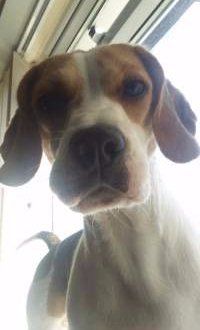

Millie, 1 year old
Photo courtesy of Jackie Turner
What to do:
If you are thinking about offering your Beagle a better alternative than the water straight from your sink, there are some affordable and reasonable options:
1) Install a kitchen tap filter.This is the best option and these can be found at your local home improvement store, are relatively easy to install and inexpensive to maintain. Some attach right to the faucet and there are also water filtration systems that connect under the sink.
Once installed, you only need to swap out the filters which are typically inexpensive. Depending on the brand and model, these can filter out many of the elements that make water unsafe.
2) Use a filtering water pitcher. These are great; they come in a variety of sizes, to match your family size, or if you will just be using this for your Beagle. You just fill these up with tap water, and then as you pour the water out from the pitcher, the filter cleans out all of the toxins.
This is an effective - and easy- method to ensure that the water your Beagle drinks is safe.
3) Gallons of bottled water.
This is not the most penny-saving option for most, however if you are trying to decide which route to go or are waiting for a delivery of a fountain or filter, bottled water may not necessarily break the bank.
In many large supermarket chain stores, 2 gallons can be purchased for $1… which is reasonable for those who have Beagle puppies.
How to Encourage Your Beagle to Drink More
There are several effective methods to make sure that your Beagle stays hydrated:
1) Use the right bowl - You'll want to use appropriately sized stainless steel, slow feeder bowls.
2) Wash the bowl every day -
Small particles of food, the above mentioned 'slime' due to saliva and bacteria and small hairs all call out for the bowl to be washed every day with hot water and soap.
3) Employ a fountain -
Dogs are much more likely to drink more often when the trickling sound and sight of flowing water attracts their attention. This is a great way to get a dog to drink more throughout the day. This will not catch as many chemicals as the systems that connect to your sink, so you may want to fill the container with water that is filtered first.
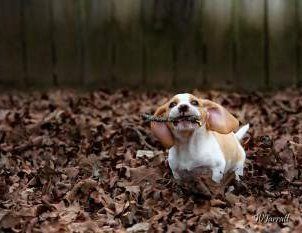
Devon, 3 months old
Photo courtesy of Wally Jarratt
4) Offer foods with high water content -
A percentage of the water that your Beagle ingests does not need to be lapped up… food with high water content can also contribute to his daily intake.
Fruit is the way to go since many are low in calories and high in nutrients. Watermelon and strawberries are two fruits
that are very high in water (92% per volume) and are safe for canines to eat.
Getting a Beagle To Drink Water When Sick
It's rough watching your Beagle get sick and it's even worse when you know that he's becoming dehydrated but refuses to drink. Vomiting and/or diarrhea can quickly drain a dog's body of water, leaving him even weaker and more lethargic than before.
While dogs of any age
can need emergency veterinary care due to this, young puppies and older, senior Beagles are most at risk.
You'll want to keep a close eye on your dog to watch for signs of dehydration, even if the following methods seem to be working, since ingesting a small amount of water may not be enough for the body to gain back what was lost.
1) Offer Pedialyte.
This is safe to give to dogs and can work to restore electrolytes , helping to balance out what was lost during a vomiting episode or bout of diarrhea. We recommend a 50/50 mix of Pedialyte and water. Due to the flavoring (orange, blue raspberry, fruit blend, etc.) a Beagle may be more tempted than with just plain water.
2) Offer frozen cubes.
When a dog is feeling ill, he may not want to drink from his bowl, but may be more willing to lick at a frozen cube of either water or water mixed with an oral hydrating solution.
3) Refrain from giving food.
In the 24 hours following stomach distress, most dogs need to have a break from food, which gives the stomach and digestive system a chance to rest. If you try to make your dog eat when he's not necessarily hungry
and
drink, this may simply be too much for him. Aim to encourage water intake first and as he gains back strength, you can then offer a bland diet.
4) Seek veterinary care -
If your Beagle refuses to drink any water at all for more than 24 hours and/or shows any signs of distress (panting, sunken in eyes, pale gums, extreme lethargy), contact the veterinarian.


Emma, 3 years old
Photo courtesy of Andy & Wendy Starkey, Rockwall, Texas
Quick Reader Q&A
Q: Is it safe for my Beagle to drink from puddles?
A:
This is a great question and we're happy to address this since it is important for all owners to know the answer. Even fresh puddles from newly fallen rain water are unsafe for dogs to drink from.
On warmer winter days and in the spring, as snow melts and creates puddles, this is when ice melt chemicals can be present in high amounts and it is toxic.
During warm months (spring and summer), this is when insects lay eggs in stagnant water puddles and ingestion of those microscopic eggs can lead to transmitted disease.
At any time of the year, if a Beagle drinks from a puddle, he can be ingesting pesticides, traces of fuel, bacteria and the feces of other animals; this can all lead to quite severe stomach distress and/or disease.
Q: Will anything happen if my Beagle drinks water from the lake that we visit?
A:
If a Beagle is swimming in a lake that looks clean and clear and swallows some water along the way, this will not necessarily present a problem.
However, in regard to stagnant ponds and lakes, there is a high probability of the water being contaminated with both the feces and urine of wild animals. This can lead to infection including Giardia and Leptrospira.
And dogs can catch these serious diseases just from swimming in that type of water, let alone drinking it. Both the Giardia and the Leptospirosis inoculations are voluntary vaccinations, so many Beagles are not protected.
Q: How bad is it if my Beagle drinks from the toilet?
A:
We are glad that we can address this since it is surprising how many sources claim that this is safe. It is not safe for a Beagle to drink from the toilet. One main issue is bacteria, most notably the C. difficile bacteria that can cause moderate to severe stomach distress.
Another issue is the presence of cleaning chemicals which are toxic. These would be from both those placed in the tank and residue of those used to scrub the bowl.
Are You a BeaglePro Member?
Become a Free BeaglePro Member
to receive updates when we new pages of info to this site. You will also be able to suggest a topic for us to write about. ***
If you are already a Member, just reply to any newsletter with your suggestion.
You May Also Like:
Top Beagle Care Tips
- For Beagles of all ages, the most important elements for optimal health.
Beagle Separation Anxiety
- This is a common problem for this breed. Great, effective tips.
Share Us
Share
Tweet
Share
Mail
All text and photographs protected by US and International copyright laws.
Copyright. BeaglePro.com
We are a participant in the Amazon Services LLC Associates Program, an affiliate advertising program designed to provide a means for us to earn fees by linking to Amazon.com and affiliated sites.

